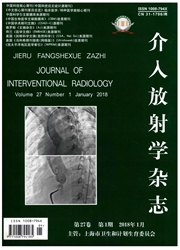

 中文摘要:
中文摘要:
目的:探索利用负载131I的骨水泥行经皮椎体成形术(PVP)治疗兔椎体肿瘤的安全性及有效性。方法将12只采用经皮穿刺接种法建立的兔VX2椎体肿瘤模型随机分成实验组和对照组,每组6只。实验组注射负载有放射性核素131I的骨水泥行PVP,对照组单纯注射骨水泥行PVP。两组实验动物于术前1 d、术后第4天检测血细胞计数,于PVP术前1 d及术后第1、4、8天行PET-CT检查,测定椎体肿瘤的核素标准化摄取值(SUV)。 PVP后第1、4、8天对实验组动物行SPECT检查,了解131I在体内分布情况,在治疗后第8天取肿瘤椎体标本行病理检查。结果所有实验动物都顺利接受PVP治疗,实验组的放射性核素平均使用放射剂量为(0.82±0.14)mCi/kg。两组实验动物PVP前、后血细胞计数结果差异无统计学意义。PVP后SPECT检查见131I主要聚集在病变椎体内,术后各时间点内其分布无明显变化。两组动物术前SUV值差异无统计学意义(F=0.765,P>0.05),实验组动物PVP后椎体肿瘤的SUV值较术前明显降低,且数值稳定(F=423.792,P<0.05)。病理检查结果显示实验组骨水泥周边肿瘤细胞坏死范围明显大于对照组。结论采用负载131I的骨水泥行PVP治疗椎体肿瘤,方法可行,短期内随访结果安全、有效。
 英文摘要:
英文摘要:
Objective To preliminarily evaluate the safety and efficacy of percutaneous vertebroplasty (PVP) with 131I-loaded bone cement in treating vertebral tumor in rabbit models. Methods Twelve New Zealand white rabbits with lumbar vertebral tumor, which was established by puncturing transplant of VX2 carcinoma, were randomly and equally divided into the study group and the control group with 6 rabbits in each group. PVP with injection of 131I-loaded bone cement was carried out in the rabbits of the study group, while PVP with injection of pure bone cement was employed in the rabbits of the control group. The blood cell count was determined in all the animals one day before PVP as well as on the 4th day after PVP. PET-CT examination was performed one day before PVP as well as on the 4th day after PVP to check the stand uptake value (SUV) of each vertebral tumor. SPECT was performed in all rabbits of the study group at one, 4 and 8 days after PVP respectively to estimate the distribution of 131I in the animals' bodies. Eight days after PVP,the rabbits were executed and the tissues of tumor were collected for pathological examination. The results were statistically analyzed. Results PVP procedure was successfully accomplished in all the animal models. The average radiation dose of 131I used in the study group was (0.82 ± 0.14) mCi/kg. No statistically significant differences in the blood cell counts, which were determined both before and after PVP, existed between the study group and the control group. SPECT that was performed after PVP indicated that 131I was mainly accumulated within PVP-treated vertebrae, and the distribution of 1311 showed no obvious changes at different points of time after the procedure. Before PVP, the difference in SUV between the two groups was of no statistical significance (F = 0.765, P 〉 0.05). In the study group, the postoperative SUV was significantly lower than the preoperative SUV (F = 423.792, P 〈 0.05). Pathological examination showed that the extent of tumor c
 同期刊论文项目
同期刊论文项目
 同项目期刊论文
同项目期刊论文
 期刊信息
期刊信息
